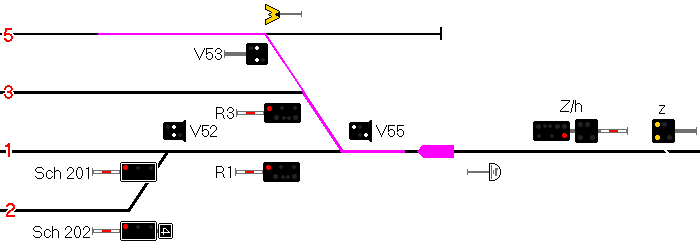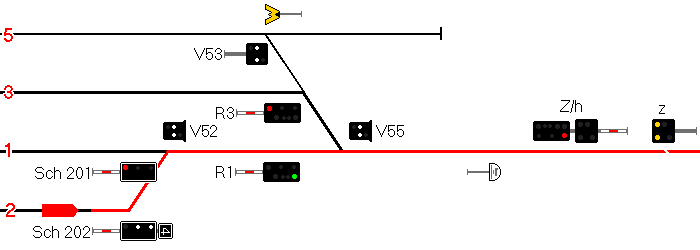|
|
|
Important Note: This web site has not been updated since 2003 and is therefore not up-to-date. See here.
| 1. | 2. | 3. | 4. | |
  |
 |
|
 |
Shunting forbidden (Verschubverbot) § 23 (2) |
  |
 |
|
 |
Shunting admitted (Verschubverbot aufgehoben) § 23 (4) |
| Detail | ||
|
|
 |
Shunting limit
(Verschubhalttafel)
§ 23 (17) |
|
|
If it is not clear which track the shunting limit refers to it is supplemented by an arrow showing to the belonging track. |
|
|
|
Waiting signal
(Wartesignal)
§ 23 (14) |
|
|
|
Waiting signal with signal ''Shunting admitted''. |
 |
|
The speed indicator on top of »Sch 202« has no relevance for the shunting movement since shunting is always performed under stop on sight condition! |
 |
 |
|
Note that signal aspect of »Sch 202« is the same as it was for the shunting movement in the first example but exit signal »R1« is showing ''clear'' rather than »shunting admitted«. |
![[vez2.gif]](gfk/sigalyt/vez2.gif) |
|
As one can see, the shunting signals »V55« and »V52« do not show a proceed aspect. |
 |
Stop (Abdrücken verboten) |
 |
Push slowly (Langsam abdrücken) |
 |
Push with moderate speed (Mäßig schnell abdrücken) |
(Last Update: 18.11.2002)
![]() This website is published under a creative commons license.
Furthermore, use of the contents in the wikipedia is explicitely allowed.
This website is published under a creative commons license.
Furthermore, use of the contents in the wikipedia is explicitely allowed.
Errors and Omissions excepted!